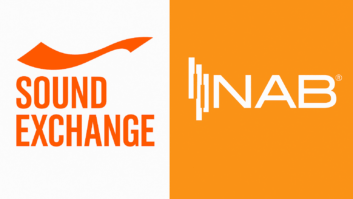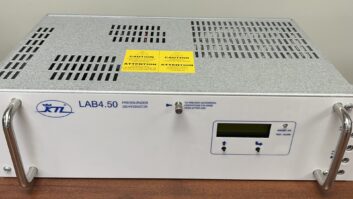
Deepen Sinha
Technology supplier ATC Labs believes that large-scale streaming represents an underappreciated opportunity for broadcasters. Radio World caught up with Dr. Deepen Sinha, founder and CEO of Audio Technologies and Codecs Inc., better known as ATC Labs.
RW: What is ATC Labs and what is its business?
Sinha: ATC Labs is a technology company that provides audio codecs, audio processors, video processors, AoIP communication tools and streaming media solutions. Our portfolio of products includes Perceptual SoundMax Q24 24-band audio processors, ALCO Professional IP SoftCodec/SoftSTL and a range of compression/processing technology modules.
We have recently also introduced an end-to-end solution for Internet radio that provides not only the Perceptual SoundMax Q24 audio processor but integrated quality optimized AAC+/MP3 encoder and a truly universal Web page player that does not require downloads or apps to play on smartphones, tablets or computers.
In partnership with Amazon Web Services, we also offer the bandwidth and worldwide CDN access as part of the package. A truly start to finish solution.
RW: Who are some of your notable radio broadcast clients?
Sinha: ATC Labs provides custom audio R&D services, audio processing and codec technologies and finished products to SiriusXM. For instance the Perceptual SoundMax audio processor is being deployed on all of Sirius XM Internet audio streams as well as on a substantial portion of their satellite channels.
In addition, All India Radio (AIR), the largest broadcaster in India, recently selected ATC Labs for their IP codec requirements for over the air broadcasts with remote reporting. We are also in the process of implementing Internet radio streams for AIR with our processing and encoding. Additionally, our processors and IP codecs were selected for WSOU Seton Hall, WJTB NJIT Radio, WETD Alfred State Radio, Delhi University Community Radio (DUCR) and Radio Noida, among others.

SoundMax Manager, lets an operator configure and fine-tune the quality of hundreds of audio streams from one console. The Tuning Screen is shown. RW: Big picture, where are we in the evolution of audio delivery for broadcasters?
Sinha: Use of IP-based technologies end to end — namely for bringing content to the studio, routing it within the studio, and eventually delivering it to the listeners — is obviously the way things are headed. Furthermore, today’s broadcasters have the option to use either hardware or software solutions for audio processing, codecs and streaming. Often a judicious mix of software products along with hardware allows for more streamlined workflow, compact rack-space organization, energy management and the use of powerful tools for centralized control and monitoring.
For example, the Perceptual SoundMax Q24 audio processor is offered both in a conventional hardware form and, for large-scale users, a server configuration that allows for up to 24 full-capability audio processors (each with full 24-band audio processing) in a single 1U rack hardware. Using the SoundMax Manager, an operator can then configure and fine-tune the quality of literally hundreds of audio streams from a single console.
RW: What is 24 Band Perceptual SoundMax and why does it matter?
Sinha: The Perceptual SoundMax Q24 audio processor is one of the most advanced audio processors available on the market. It combines latest research in psychoacoustics and multi-band signal processing and includes not only the powerful 24-band dynamics processing and loudness management but also unique processing tools for noise reduction, listener fatigue reduction and stereo control. To ensure the quality audio stream is delivered downstream, a highly optimized AAC+ encoder and a streamer moves the content to any IP destination or distribution servers.
As I mentioned it is also being offered in an interesting Q24Ser software flavor that can be put to work for just one or two channel solution, very popular with college stations and community broadcasters, or can scale up to 20+ channels on a 1U rack unit for a large broadcaster. We have chosen to incorporate 24-band processing because we find that it is crucial for ensuring the clarity of vocals and mid-bass in a complex piece of music.
RW: What other technical barriers do radio stations face to creating smooth, continuous streams to various listening devices?
Sinha: Listeners want immediate access to the streams. Downloads, page diversion to a hosting site or grabbing an app is just too slow and will not build listener loyalty to a radio station. Circumventing the technical barrier to providing a truly universal player that is embedded within the radio station’s own Web page, as we now provide, is more than a market advantage, it is a market must. Our player supports AAC+ for the primary stream but can also switch to the backup MP3 channel provided by the Perceptual SoundMax Q24 if a mobile device does not support either the full power of HTML5 or flash. Mobile devices are quickly becoming the platform for listeners and audio processing for a great sound experience on those devices requires very fine controls that only 24 bands can provide.
RW: Can you offer any technical tip or advice based on what other stations have done … common errors to avoid?
Sinha: Streamline the signal path, especially if the broadcaster is offering multiple streams. Having one hardware server device, be it rack or workstation, provides professional-grade audio processing, AAC+/MP3 encoding and link to the cloud-based Content Distribution Network saves time and money. One blade server can support almost everything you need for up to 24 audio streaming channels.
RW:What else do we need to know?
Sinha: Audio processing and codecs have been our core competency to this point but we are also expanding to the video encoding and processing market with products that offer the same efficiency, quality and economy of scale as the Perceptual SoundMax Q24 audio processor. We have also recently introduced a line of ultra-low-delay audio codecs with codec algorithmic delay being less than 1 msec.







